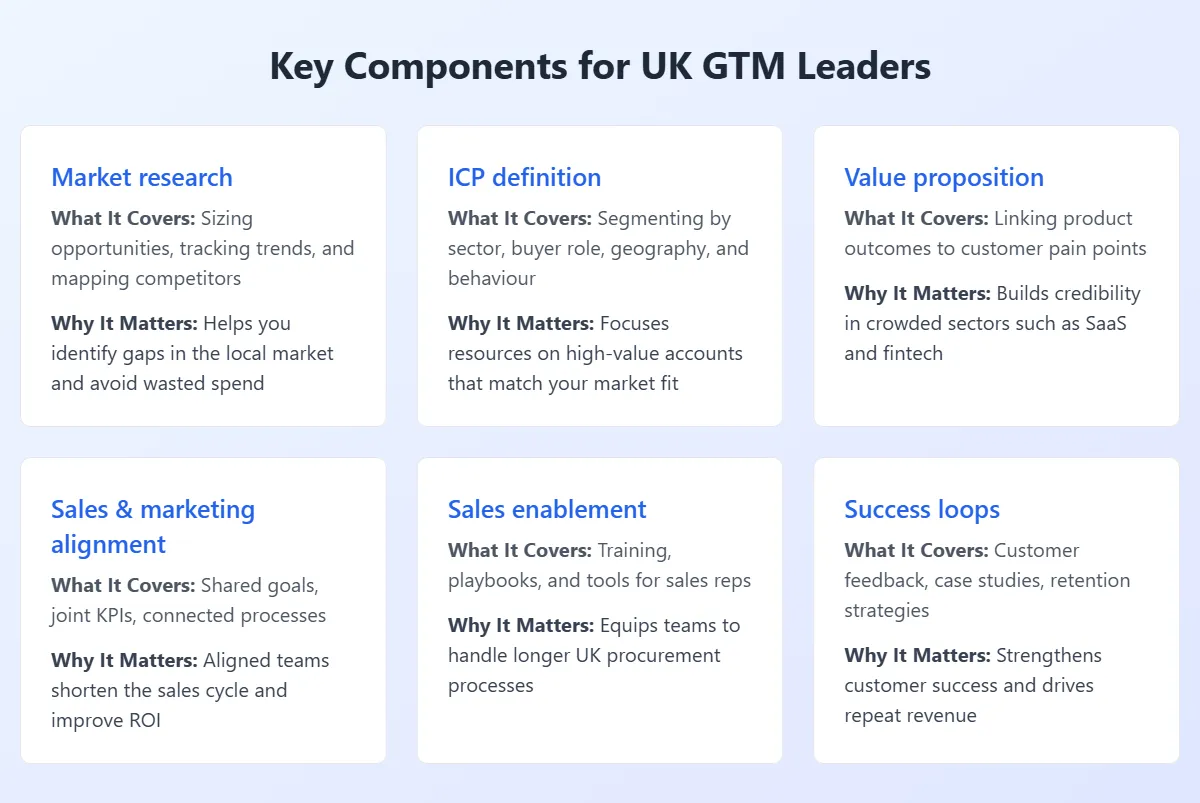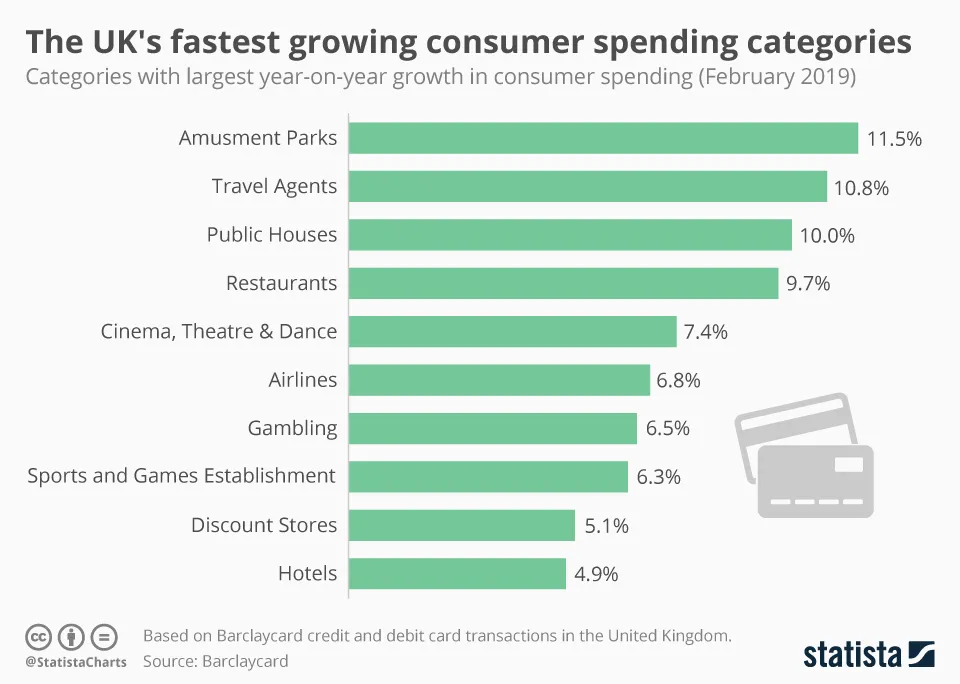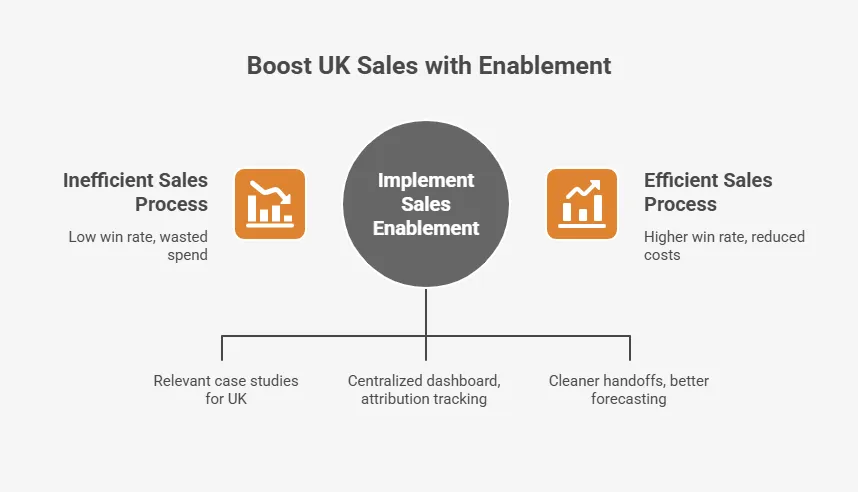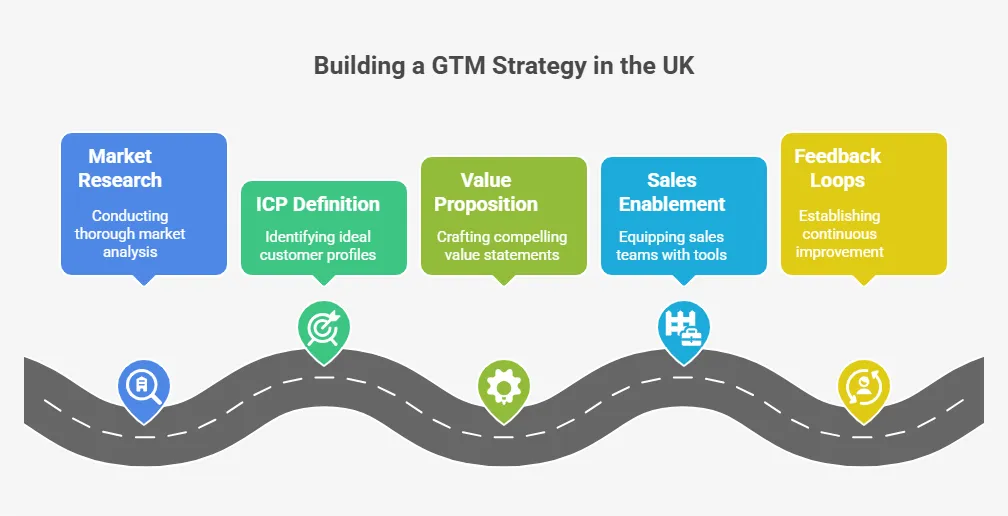The United Kingdom is one of the most attractive, but also most complex, markets for tech expansion.
Strong funding signals prove the draw: in 2024, UK startups raised $16.4 billion, which made the country the world’s third-largest tech hub.
But opportunity comes with hurdles.
Competition is fierce, compliance is demanding, and long buying cycles can stall momentum. If you want to succeed, you need a strategy tailored to UK buyer behavior and market realities.
This playbook gives you exactly that: a UK-focused go-to-market framework designed for startups, scaleups, and enterprise teams.
You’ll learn how to align business goals with local buyer expectations, sharpen execution, and accelerate growth.
But before we move to the tactical sections, let’s clarify what a go-to-market plan actually means.
TL;DR
The UK is the world’s third-largest tech hub, attracting $16.4B in 2024 funding, but success requires local adaptation due to fierce competition, complex regulations, and long sales cycles.
A Go-To-Market (GTM) strategy aligns product, sales, and marketing around revenue generation, covering ICP definition, positioning, acquisition, and retention.
In the UK, GTM planning helps manage risks, tailor communication to buyer preferences, and comply with regional norms such as FCA or NHS standards.
Core Components of a UK GTM Playbook:
- Market research to identify opportunities and competition.
- A clearly defined Ideal Customer Profile (ICP) reflecting UK buyer behavior.
- A localized value proposition that aligns with compliance and trust-building.
- Sales and marketing alignment with shared metrics and enablement resources.
- Feedback loops for continuous optimization.
GTM Strategy Models:
- Outbound: Direct outreach, effective for enterprise sales.
- Inbound: Content-led lead generation at lower costs.
- Account-Based Marketing (ABM): Precision targeting of high-value B2B accounts.
- Demand Generation: Multi-channel campaigns for brand awareness and lead nurturing.
Best Practices for the UK Market
- Understand market diversity across England, Scotland, Wales, and Northern Ireland.
- Focus on high-growth sectors like fintech, SaaS, and healthtech.
- Benchmark competitors using UK-specific tools like Dealroom and Beauhurst.
- Develop a UK-specific value proposition emphasizing compliance and ROI.
- Localize positioning, tone, and humor for British audiences.
- Combine digital and offline channels; LinkedIn and trade events are key.
- Build partner networks for credibility and reach.
Execution Essentials
- Equip sales teams with localized content and role-based messaging.
- Use RevOps for centralized data, attribution, and process efficiency.
- Allocate budgets strategically, about 50% of SaaS revenue typically goes to GTM.
- Measure success with CAC payback, LTV:CAC ratio, and pipeline velocity.
Regulatory and Compliance Focus
- Align early with FCA and NHS Digital to avoid license delays.
- Maintain GDPR compliance and transparent data governance.
Case Studies
- NielsenIQ: Achieved scalable multilingual panel recruitment through creator-led content.
- OakNorth: Thrived via strong compliance and SME lending focus.
- Revolut: Faced setbacks due to regulatory missteps.
Key Takeaways
- Market research, ICP definition, and compliance readiness are non-negotiable.
- Data-driven measurement ensures sustainable growth and investor confidence.
- inBeat Agency provides research-backed GTM strategy and creative execution for brands expanding into the UK.
What Is a Go-To-Market (GTM) Strategy?
A Go-To-Market (GTM) strategy is your blueprint for reaching the right buyers with the right product at the right time. It aligns product, sales, and marketing into one plan so you avoid fragmented execution.
Unlike a marketing plan, which focuses on promotion and brand awareness, a GTM plan covers the entire path to revenue. It spans from defining your target segments to customer acquisition and retention.
The truth is, thousands of products and services are launched each year. And research from Harvard shows that about 95% fail. A well-defined GTM plan is the key to achieving traction and avoiding wasted investment.
Why Do You Need a Go-To-Market Strategy in the UK?
Entering the UK (or any country) without a GTM plan exposes you to high costs and slow adoption. To succeed in a new market, you need a solid plan, backed by research, that’s relevant to your industry and niche.
According to Ernst & Young, 53% of investors expect the UK to become increasingly attractive for foreign direct investment, which shows clear confidence in the market.
But to tap the rewards of this market you need precise positioning and execution.
More importantly, a GTM strategy shields you from risks, which a mature market like the UK may pose.
Specifically for the UK, a GTM plan forces the business to conduct necessary market and competitor analysis to understand local nuances. That could unlock insights like the preference for relationship-based selling over high-pressure tactics or the dry, self-deprecating nature of British humor in messaging.
Next, let’s break down the critical elements that make a GTM playbook actionable in practice.
Key Components of a GTM Playbook
A strong playbook brings structure to what might otherwise feel like a fragmented execution. Without it, teams skip critical steps. 15.4% of companies admit they lack a defined GTM approach.
The building blocks of a good GTM playbook are:
- Market research to size opportunities and understand the competitiveness.
- A precise ICP definition that reflects sector, geography, and buyer behaviour.
- A value proposition that connects your solution to real customer outcomes.
- Alignment of sales and marketing teams around shared metrics. Firms with strong alignment are 67% better at closing deals, retain 58% more customers, and generate 208% more revenue from marketing.
- Sales enablement programs that give sales representatives the content, training, and data they need.
- Feedback loops from customers and partners that sharpen execution over time.
Companies that follow GTM consistently see 10% higher success rates and triple the revenue growth compared to peers, according to Salesmate. The image below gives you a quick framework view that you can adapt to your own organisation.

Next, we’ll look at the different strategy models you can use to bring this playbook to life.
Types of GTM Strategies
The playbook you build should match the stage of your company and the realities of the UK local market. Each approach has strengths and trade-offs.
Here are the common types of GTM strategies:
Outbound
Outbound is a proactive strategy where a company initiates direct contact with potential customers, using methods like cold calls, email campaigns, and targeted advertising. It’s effective for high-value enterprise accounts, but it comes with risks associated with a long sales cycle.
For example, cold calling in high-complexity sectors typically takes an average of 110 days to close deals. This makes it a slow but sometimes necessary path.
Inbound
Inbound is a reactive strategy focused on attracting customers by creating and distributing valuable content that addresses their problems, leading them to find the company organically through channels like Search Engine Optimization (SEO), paid media, and social media.
It generates 54% more leads, and according to HubSpot data, it costs 62% less per lead than outbound methods.
Account-based marketing
Account-Based Marketing (ABM) is a highly focused strategy where sales and marketing align to treat a small, pre-selected group of high-value target companies (accounts) as individual markets.
This strategy is primarily for B2B companies selling high-margin, complex solutions to enterprise-level clients. According to Gartner, ABM programs increase pipeline conversion rates by 14%.
Demand generation
Demand generation is an umbrella strategy that blends content, paid campaigns, and marketing channels such as LinkedIn or niche UK events to build sustained growth. This approach is good for companies in a growth phase looking to expand their market reach, create buzz, and nurture a large pool of qualified leads into customers.
Pro tip: Confused as to what GTM strategy best suits your business? Discover the best UK GTM agencies who can help you choose the best option and break into the market with impact.
Best Practices for Building a GTM Strategy in the UK
Building a strong GTM plan means adapting proven methods to UK buyer behaviour. The next steps outline what improves customer success and accelerates expansion.
1. Understand the UK Market
The first order of business when creating a GTM strategy for the British market is to understand it. While the UK in in Europe, it’s economy and culture are markedly different from continental Europe. And after the breakaway from EU, the legal and logistics are also somewhat different.
Plus, the UK is made up of four different countries. So, it’s important to understand the differences as things like purchasing power and buying behaviors can vary by country, region, and cities. For instance, London is a very different market compared to the rest of the UK, as it has a multicultural population, higher wages, but is also way more expensive. Those differences can play a huge role on how a business performs.
London isn’t the only growth engine. Manchester is now the UK’s fastest-growing fintech hub. It contributes more than £1 billion to the regional economy and is home to about 250 fintech firms.
Beyond these centres, the UK counts eight regional hotspots for fast-growth tech. This indicates that innovation is not confined to the capital. These centres matter for talent, partnerships, and localized customer engagement.
Aldi is a good example of this. The company focused on value, simplicity, and local sourcing, which helped establish trust and break into a highly competitive UK retail market. UK buyers weren’t as thrifty as Germans, where Aldi is originally from, but as prices soar, Aldi came out on top with its no-frills, simple, fast, and cheap checkouts.

2. Define Your Ideal Customer Profile (ICP) in the UK
Building a repeatable playbook starts with segmenting the market.
In the UK, the largest opportunities are in fintech, B2B SaaS, and healthcare technology (healthtech). According to imarc, the SaaS sector alone was valued at $16.3 billion in 2024. It’s projected to grow by 13.49% annually through 2033, which makes competition for attention high.
Buyer personas vary across verticals, and each group views vendors through a distinct lens. Finance leaders focus on ROI, procurement teams scrutinize compliance and pricing, while IT gatekeepers weigh integration risks.
Pro tip: Adding to this, studies show that 90.5% of UK and European buyers already have prior experience with a vendor when reviewing options. This means you rarely enter as a blank slate since most evaluations happen against an existing reference point.
However, there are some tools that can help you refine targeting.
For instance, for B2B brands, our experts use LinkedIn Sales Navigator because it identifies role-specific decision-makers. SparkToro uncovers where UK audiences spend time online. So, combining these insights with ICP interviews gives you a better view of who to reach and how to win.
3. Market Research and Competitive Benchmarking
To win in the UK, you need to map your competitive landscape with more precision than in broader EU or US markets.
The UK typically has fewer late-stage funding deals, with Series C+ rounds accounting for approximately 20% of VC investment in 2024, compared to 35% in the US. That means more startups compete for early funding, so you face crowded entry points.
You should track where competitors are securing traction. There were over 15,000 new tech startups registered in Q2 2025 alone, which is a 28% year-over-year jump. This growth indicates fresh rivals but also validates market appetite.
Tools such as Crunchbase, Dealroom, and Beauhurst can help you analyze funding signals and spot adoption patterns.
But here's the thing.
Benchmarking requires looking at UK-specific buyer sentiment and adoption speed. When you anchor research in actual customer behavior, you reduce the risk of misjudging market entry timing.
ŠKODA UK did this for the launch of KODIAQ, a crossover car, and benchmarked media and PR performance. It shows how even in mature markets, measuring against clear metrics helps refine tactics.
4. Build a UK-Specific Value Proposition
Your message must cut through UK buyer skepticism. Long procurement cycles and cautious finance teams demand clear evidence of value, especially in some niches. On top of that, generic claims fall flat.
So, you need to show measurable outcomes and price models that reflect sensitivity in a post-funding downturn. You also need to show compliance readiness for regulators such as the Financial Conduct Authority (FCA) in fintech or the NHS in healthtech.
A good example is Marqeta, the US card issuer that set up its London office in 2018.
Instead of reusing US positioning, they built a European brand narrative that introduced local compliance, developer flexibility, and customer success stories.
The company partnered with agencies while using targeted content and events to build trust and expand its market presence.
A UK value proposition would be strong if it combines clear regulatory signals, proof of efficiency, and tailored relevance to decision-makers.
5. Positioning and Messaging for the UK Market
Positioning in the UK needs to go beyond broad claims.
Frameworks such as Jobs-to-Be-Done help you frame the specific outcomes buyers want. At the same time, category creation or sharper differentiation clarifies how you stand apart.
This is vital in SaaS, fintech, and healthtech, where existing businesses may already be dominating.
But you don't have to take our word for it.
Here's what April Dunford, an expert at positioning and author of Obviously Awesome, has to say:
“Clear positioning helps prospects understand that you are a leader in your market segment and that you offer considerable value, making it easier for you to charge a premium.”
UK deals are rarely decided by one person, especially in the B2B space.
Studies show that 60% of B2B purchases involve four or more people reviewing the choice. That means your messaging must speak to multiple stakeholders. A value pitch that resonates with one function but fails with another will stall in committee.
To succeed, you should craft layered messaging that adapts to each role’s priorities while remaining consistent throughout the entire buyer’s journey. This balance builds credibility and helps you move deals through longer UK evaluation cycles.
McDonald’s gives us a good lesson in positioning with its McCafe brand coffee.
The brand faced hurdles initially because it was seen as a cheap coffee without the ‘coffee shop experience.’ And they believed their product was just as good as those sold for higher prices in coffee franchises and niche stores.
Well, they took those very assumptions and made it their position that McCafe coffee is simple and value-focused, poking fun at the outrageously priced coffees at other places.
The campaigns with this position catapulted McDonalds to the number two spot in the country.
6. Channel Strategy: Where to Reach UK Buyers
Reaching UK buyers requires a balanced channel mix. Today, digital platforms form the backbone of outreach. But even in digital marketing channels, you have plenty of variety, and one may be more beneficial than others.
For example, LinkedIn is especially dominant in B2B marketing, with 97% of marketers using it and 82% saying it delivers higher-quality leads than other platforms.
On the other hand, TikTok is dominant in B2C, especially for influencer campaigns that build trust with young buyers.
Paid search and retargeting on niche channels can add early-funnel momentum.
However, offline presence still matters. In fact, 95% of UK exhibitors report that in-person events drive stronger engagement than virtual formats.
Trade shows, accelerator programs, and B2B events, such as London Tech Week or SaaStock, provide an opportunity to meet buyers face-to-face and strengthen relationships. They also help validate credibility in a cautious market.
Apart from events, building partner ecosystems can also extend your reach. Alliances with resellers or local accelerators typically open doors more quickly than direct outreach alone.
7. Sales Enablement and Revenue Operations
Equipping your UK sales force requires more than product sheets. They need:
- Localized collateral
- Relevant case studies
- Training that addresses procurement-heavy buying groups
The sales enablement platform market in the UK already exceeded $360 million in 2024 and is projected to more than double by 2030.
This shows how central it has become.
And above all else, companies that implement sales enablement report a 49% win rate on forecasted deals, compared to 42.5% for those without it.
Revenue Operations brings discipline across marketing, sales, and customer success.
With a centralized dashboard, attribution tracking, and CRM alignment, you gain visibility across the sales models driving results.
Boston Consulting Group found that organizations adopting RevOps achieved a 10-20% boost in sales productivity and cut GTM costs by 30%. For you, this means cleaner handoffs, better forecasting, and less wasted spend.

8. Regulatory and Compliance Considerations
In the UK, regulatory compliance is a gatekeeper.
For example, fintech companies must work through the FCA.
In 2025 alone, the FCA granted 11 new Electronic Money Institution licenses and 6 Authorised Payment Institution licenses. However, it also revoked 14 licenses, which proves that approval comes with strict oversight. A weak compliance plan can stall your product launch before it begins.
Healthtech faces its own thorny path.
NHS Digital sets rigorous requirements for data security, integration, and patient safety. In fact, one study of 796 mHealth apps found 23.7% lacked a full privacy policy, and many had mismatches in how sensitive data was collected and transmitted.
Without early alignment on data governance, your rollout risks long delays and lost partnerships.
Data compliance adds another layer.
GDPR remains the baseline, but many firms underestimate its reach. A recent survey showed that nearly half of European businesses admit they are still unclear on GDPR’s full implications.
To avoid regulatory obstacles and pushback, do your homework as part of the GTM process. Treat privacy and governance as core parts of your strategy from day one, instead of legal formalities.
9. Budgeting and Resource Allocation
Getting budgets right in the UK requires balancing growth ambitions with lean execution.
Resource allocation typically leans heavily into go-to-market spend. For example, it’s common for SaaS firms to direct 50% or more of revenue into sales and marketing during growth phases. Within that, around 10-15% of the overall budget is typically invested in platforms and tools such as CRM, attribution, and analytics.
This spend is what equips teams to track efficiency and scale intelligently when going into a new market.
But that’s the scenario with SaaS.
For other industries and niches, the benchmarks may be different.
Even then, there’s nothing set in stone, as your circumstances will eventually dictate how much money you spend on GTM.
One thing is for sure:
You should plan your budget with granular detail and allocate it smartly.
For instance, you wouldn’t dedicate most of your budget towards awareness in a market where customer service quality trumps everything else.
Again, that takes us back to the market research and ICP. Use the takeaways from your market research to adjust budget allocation. Prioritize spending on areas that have the most potential.
Also, the split should extend beyond marketing. You also need reserves for product improvements, enablement, and compliance.
10. Testing and Measuring GTM Success in the UK
Testing your GTM plan means anchoring decisions in hard data.
In SaaS, CAC payback is a key signal.
The 2025 CAC Payback Benchmarks report shows recovery times typically range from 12 months in SMB segments to 24 months in enterprise deals.
Measurement methods can distinguish between what drives true growth and noise. Incrementality testing clarifies causal lift. At the same time, media mix modeling links spending to outcomes across digital and offline channels.
At inBeat Agency, we support this with GA4 dashboards, attribution models, and predictive analytics that help you forecast ROI with greater confidence.
This structure gives you clear visibility, sharper budget control, and the ability to demonstrate efficiency to investors.
Case Studies: UK Market Entry Wins and Misses
The UK, as a big economy, has many stories of new businesses entering the market and winning or losing. And there are lessons to be learned from that.
NielsenIQ: The GTM Influencer Playbook
NielsenIQ, with the help of inBeat Agency, used multilingual user-generated content to recruit panels across 20+ languages and 19 countries, including the UK.
Here’s one example:
This drove global panelist acquisition while keeping CPA under control.
For NielsenlQ, we coordinated over 100 creators each month and deployed localized creative at scale. The results showed that adapting to cultural and linguistic nuances is crucial for rapid expansion.
OakNorth: Compliance and Strong USP
Another success story is OakNorth, a fintech lender to SMEs. It achieved success by aligning with UK regulatory standards and banking needs.
In 2019, the brand secured £327 million in funding, the largest single round for a European fintech at the time.
This shows how compliance and credibility with traditional banks can unlock investor trust and growth.
Of course, OakNorth also has a solid value proposition to stand apart from its competitors:
Revolut: The Not-so-Good Example
Unlike OakNorth, Revolut stumbled when it came to regulatory requirements.
Initially, it grew rapidly with seamless onboarding and tactical pricing but faced FCA licensing issues and other security hurdles:


